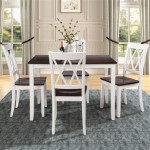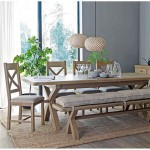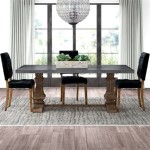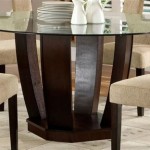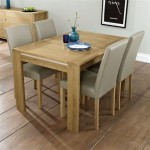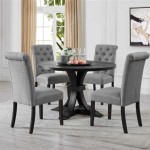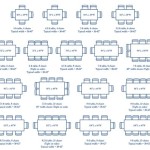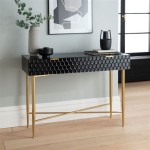Rectangular Pedestal Dining Room Tables: A Comprehensive Guide
Rectangular pedestal dining room tables represent a popular and versatile choice for homeowners seeking a balance of style, functionality, and space efficiency. Unlike tables with traditional four-legged designs, pedestal tables offer a single, central base or a configuration of connected bases, providing several advantages in terms of seating flexibility, legroom, and aesthetic appeal. This article delves into the various aspects of rectangular pedestal dining room tables, exploring their design considerations, material options, size variations, and suitability for different dining room settings.
Design and Construction of Rectangular Pedestal Tables
The design of a rectangular pedestal dining room table centers around the support structure that connects the tabletop to the floor. This pedestal base is the defining characteristic and can take various forms, significantly influencing the table's overall style and stability. Common designs include a single, thick column, a cluster of slender columns, a geometric arrangement of wooden or metal supports, or a trestle-style base with a horizontal beam connecting two pedestal legs.
The construction of the pedestal is crucial for ensuring stability and weight-bearing capacity. A solid wood pedestal, particularly one made from hardwood species like oak, maple, or walnut, offers excellent strength and durability. Metal pedestals, often crafted from steel or wrought iron, provide a contemporary look and can also be incredibly robust. For larger tables, multiple pedestals may be incorporated to distribute the weight evenly and prevent sagging or instability in the tabletop.
The tabletop itself is another critical component. Rectangular tabletops are available in a wide range of materials, including solid wood, wood veneers, glass, stone (such as marble or granite), and engineered materials like MDF (Medium Density Fiberboard) and plywood. The choice of material will impact the table's appearance, durability, and maintenance requirements. Solid wood offers a classic, warm aesthetic and can be refinished multiple times, while glass provides a sleek, modern look but may require more frequent cleaning. Stone tabletops are exceptionally durable and resistant to heat and scratches but can be quite heavy.
The shape of the tabletop edges also contributes to the overall design. Options range from simple, square edges to rounded, beveled, or bullnose edges. The edge profile can influence the table's perceived style and the level of comfort for diners. Rounded edges, for example, are often preferred in homes with young children due to their safety benefits.
Furthermore, the finish applied to the tabletop and pedestal is essential for both aesthetics and protection. Wood finishes can range from natural oils and waxes to stains, varnishes, and lacquers. These finishes not only enhance the wood's natural grain and color but also protect it from moisture, scratches, and stains. Metal finishes can include powder coating, painting, and various plating options, each providing a unique look and level of corrosion resistance.
Material Options and Their Characteristics
The choice of materials for a rectangular pedestal dining room table significantly impacts its appearance, durability, and overall value. Each material offers a unique set of characteristics that should be carefully considered based on individual needs and preferences.
Solid Wood: Solid wood is a classic and highly desirable material for dining room tables. It offers a natural warmth and beauty that is difficult to replicate with other materials. Hardwood species like oak, maple, cherry, and walnut are particularly popular due to their strength, durability, and attractive grain patterns. Solid wood tables can be sanded and refinished multiple times, allowing them to be restored and updated over time. However, solid wood is also susceptible to changes in humidity and temperature, which can cause it to expand, contract, or even crack if not properly cared for.
Wood Veneers: Wood veneers consist of thin layers of real wood that are bonded to a core material, such as MDF or plywood. Veneered tables offer the look of solid wood at a more affordable price point. They are also less susceptible to warping and cracking than solid wood due to the stability of the core material. However, veneered tables cannot be sanded and refinished as many times as solid wood tables, and the veneer can be damaged if exposed to excessive moisture or impact.
Glass: Glass tabletops provide a sleek, modern, and airy aesthetic. They are easy to clean and maintain, and their transparency can make a small dining room feel larger and more open. Tempered glass is the preferred choice for dining tables due to its increased strength and safety. If broken, tempered glass shatters into small, relatively harmless pieces rather than sharp shards. However, glass tabletops can be prone to scratches and fingerprints, and they may not be as durable as wood or stone.
Stone: Stone tabletops, such as marble, granite, and quartz, offer exceptional durability and a luxurious aesthetic. They are highly resistant to heat, scratches, and stains, making them ideal for busy households. However, stone tabletops are also very heavy and can be quite expensive. They may also require specialized cleaning products to maintain their appearance.
Metal: Metal is often used for pedestal bases, but it can also be used for tabletops, particularly in contemporary or industrial-style dining rooms. Metal tabletops are durable and easy to clean, but they can be cold to the touch and may show scratches more easily than other materials. Metal is also a good option for outdoor dining tables due to its resistance to weather and corrosion.
Size and Space Considerations for Rectangular Pedestal Tables
Choosing the right size of rectangular pedestal dining room table is crucial for ensuring comfortable seating and adequate space for movement within the dining room. The table should be large enough to accommodate the typical number of diners but not so large that it overwhelms the space or obstructs traffic flow.
As a general guideline, each diner requires approximately 24 inches of linear space at the table and 12 inches of depth. This means that a rectangular table intended to seat six people should be at least 72 inches long and 36 inches wide. A table for eight people should be at least 96 inches long and 40 inches wide. These are minimum dimensions, and larger tables may be desired for more comfortable seating or to accommodate serving dishes and centerpieces.
In addition to the table's dimensions, it is important to consider the amount of space available in the dining room. A good rule of thumb is to allow at least 36 inches of space between the table and any walls or furniture. This will provide ample room for diners to pull out their chairs and move around the table without feeling cramped. If the dining room is used as a primary thoroughfare, even more space may be necessary.
The height of the table is another important consideration. Standard dining table height is typically between 28 and 30 inches. This height is generally comfortable for most adults when paired with standard dining chairs that have a seat height of 18 inches. However, taller or shorter individuals may prefer a table with a slightly different height. It is always a good idea to try out different table and chair combinations to ensure a comfortable and ergonomic dining experience.
For smaller dining rooms, extendable rectangular pedestal tables can be a practical solution. These tables feature leaves that can be added or removed to adjust the table's size as needed. This allows the table to be compact for everyday use but easily expanded to accommodate larger gatherings. When selecting an extendable table, it is important to ensure that the extension mechanism is smooth and easy to operate and that the leaves can be stored conveniently when not in use.
Finally, the shape of the dining room itself can influence the choice of table size and shape. In long, narrow dining rooms, a rectangular table is often the most efficient use of space. In square dining rooms, a round or square table may be more visually appealing. Ultimately, the best approach is to carefully measure the dining room and consider the layout of other furniture before making a decision on the size and shape of the dining table.

Katherine Brown Wood 94 Rectangular Double Pedestal Dining Table

Rectangular Pedestal Tables Rosehill Contract Furniture

Florence Rectangular Double Pedestal Dining Table

Rectangular Dining Table With Oval Pedestal Base Transitional Room

Stanton Rectangular Pedestal Dining Room Set In Black By Coaster Furniture Local Outlet

Rectangle Pedestal Dining Table 32 Pottery Barn

Champlain Rectangle Pedestal Dining Table Room Tables Canadel Langley Furniture Designer And Solid Wood Home Furnishing Valley Direct Surrey White Rock Abbotsford Chilliwack Maple Ridge Bc Canada

Brycemoor Rectangle Dining Table With Extension Ethan Allen

63 In Modular White Tempered Glass Rectangular Dining Table With Black Pedestal Mdf Leg Seat 6

Champlain Rectangle Pedestal Dining Table Room Tables Canadel Langley Furniture Designer And Solid Wood Home Furnishing Valley Direct Surrey White Rock Abbotsford Chilliwack Maple Ridge Bc Canada

